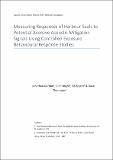Files in this item
Measuring responses of harbour seals to potential aversive acoustic mitigation signals using controlled exposure behavioural response studies
Item metadata
| dc.contributor.author | Gordon, Jonathan | |
| dc.contributor.author | Blight, Clint | |
| dc.contributor.author | Bryant, Ed | |
| dc.contributor.author | Thompson, Dave | |
| dc.date.accessioned | 2020-09-05T23:35:19Z | |
| dc.date.available | 2020-09-05T23:35:19Z | |
| dc.date.issued | 2019-09-06 | |
| dc.identifier | 261490034 | |
| dc.identifier | 9beca56a-993e-4596-8762-ad96eedbddc6 | |
| dc.identifier | 000484997200012 | |
| dc.identifier | 85071850652 | |
| dc.identifier.citation | Gordon , J , Blight , C , Bryant , E & Thompson , D 2019 , ' Measuring responses of harbour seals to potential aversive acoustic mitigation signals using controlled exposure behavioural response studies ' , Aquatic Conservation: Marine and Freshwater Ecosystems , vol. 29 , no. S1 , pp. 157-177 . https://doi.org/10.1002/aqc.3150 | en |
| dc.identifier.issn | 1052-7613 | |
| dc.identifier.other | ORCID: /0000-0003-1546-2876/work/62668390 | |
| dc.identifier.other | ORCID: /0000-0002-3481-7428/work/91340780 | |
| dc.identifier.uri | https://hdl.handle.net/10023/20569 | |
| dc.description | This work was funded by Scottish Government's Marine Mammal Scientific Support Research Programme MMSS/001/11 and UK's Natural Environment Research Council (NERC), and Department for Environment Food and Rural Affairs (NE/J004251/1) and NERC (National Capability SMRU1001). | en |
| dc.description.abstract | 1. Some anthropogenic activities pose acute risks for marine species. For example, pile driving could damage the hearing of marine mammals while underwater explosions can also result in physical damage or death. Effective mitigation is required to reduce these risks, but the exclusion zones specified in regulations can extend over hundreds or thousands of metres and seals pose particular problems because they are difficult to detect at sea. 2. Aversive sound mitigation aims to exclude animals from high‐risk areas before dangerous activities take place by broadcasting specific acoustic signals. Field research is needed to identify signals that might be effective in eliciting short‐term avoidance by marine species such as harbour seals (Phoca vitulina). A series of controlled‐exposure experiments (CEEs) were undertaken to measure seal movements in response to acoustic deterrent devices (ADD) and predator calls, and to assess the effectiveness of candidate signals for aversive sound mitigation. 3. Seals were fitted with UHF/GPS transmitters providing continuous high‐resolution tracks and real‐time transmissions of their locations. A tracking/playback vessel located seals at sea and transmitted either ADD signals or orca (Orcinus orca) calls over a range of distances while seals were foraging or moving between sites. Behaviour before, during and after exposure was analysed to assess responses. 4. One‐hundred and ten CEEs were assessed as being of at least ‘adequate’ quality. Of the 71 adequate trials with the Lofitech ADD, all 38 at ranges of <1 km (predicted received level 134.6 dB RMS re 1 μPa) elicited a response. The maximum response range was 3123 m (predicted RL: 111 dB RMS re 1 μPa). However, the responses observed did not always result in substantial movements away from the source, especially for seals that were travelling at the time of the exposures. More work is needed to better understand how exposure risks would be reduced in different scenarios. 5. The mean net speed of horizontal movements for seals responding to aversive sounds (1.15 m s−1) was only 7% higher than their mean travel speed. 6. Responses to broadcasts of orca calls were highly variable. 7. The results suggest that signals similar to those generated by a Lofitech ADD could be used to reduce risks to harbour seals from pile driving and underwater explosions in coastal waters. More work will be needed to develop systems that match the requirements of industry and regulators and to explore whether these results can be generalized to offshore waters and to other phocids. | |
| dc.format.extent | 21 | |
| dc.format.extent | 1010068 | |
| dc.language.iso | eng | |
| dc.relation.ispartof | Aquatic Conservation: Marine and Freshwater Ecosystems | en |
| dc.subject | Behaviour | en |
| dc.subject | Coastal | en |
| dc.subject | Disturbance | en |
| dc.subject | Engineering | en |
| dc.subject | Mammals | en |
| dc.subject | Renewable energy | en |
| dc.subject | Tracking | en |
| dc.subject | GC Oceanography | en |
| dc.subject | QH301 Biology | en |
| dc.subject | DAS | en |
| dc.subject | SDG 7 - Affordable and Clean Energy | en |
| dc.subject | SDG 14 - Life Below Water | en |
| dc.subject.lcc | GC | en |
| dc.subject.lcc | QH301 | en |
| dc.title | Measuring responses of harbour seals to potential aversive acoustic mitigation signals using controlled exposure behavioural response studies | en |
| dc.type | Journal article | en |
| dc.contributor.sponsor | NERC | en |
| dc.contributor.institution | University of St Andrews. School of Biology | en |
| dc.contributor.institution | University of St Andrews. Sea Mammal Research Unit | en |
| dc.contributor.institution | University of St Andrews. Marine Alliance for Science & Technology Scotland | en |
| dc.contributor.institution | University of St Andrews. Scottish Oceans Institute | en |
| dc.identifier.doi | https://doi.org/10.1002/aqc.3150 | |
| dc.description.status | Peer reviewed | en |
| dc.date.embargoedUntil | 2020-09-06 | |
| dc.identifier.grantnumber | NE/J004251/1 | en |
This item appears in the following Collection(s)
Items in the St Andrews Research Repository are protected by copyright, with all rights reserved, unless otherwise indicated.

